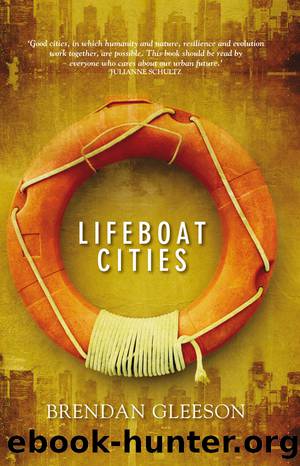Lifeboat Cities by Gleeson Brendan;

Author:Gleeson, Brendan;
Language: eng
Format: epub
Publisher: University of New South Wales Press
Published: 2010-08-12T00:00:00+00:00
8
THE URBAN VORTEX
Avoiding dangerous climate change is impossible â dangerous climate change is already here. The question is, can we avoid catastrophic climate change?
David King, UK Chief Scientist, 20071
THE AUSTRALIAN CITY TODAY â take any state capital â is a vast resource use system, dependent upon ever more extensive supply chains and regions. Economic globalisation has extended its consumption tentacles further and further across the Earth. When Sydney catches an economic cold, as it has in recent years, it hurts all sorts of far-flung suppliers and communities. Globalisation has increased the interdependency of the worldâs regions, very often meaning that people in poorer rural areas â and indeed people in cities too â rely for survival on cities they will only ever see on television screens.
Urban systems have always driven and amplified the core processes that harm climates and exhaust resources, especially during the recent freewheeling globalisation which saw the plunder of the Earthâs resources and â in many places â the weakening of environmental and civic safeguards. And yet an anti-urban perspective would be self-defeating. Humanity has embraced urban life and isnât likely to favour alternatives, whatever they may be. Opposing urbanisation or even urban life wonât get the cause of change very far. It would be no more useful than shouting into the wind.
Cities and large settlements are where the world, and especially Australia, must confront and deal with the problem of environmental bankruptcy. They are sites for containment and resolution of the threats we face, as much as they are the sources of many problems. The goal of sustainability requires transition from urban vulnerability to urban resilience. We must learn to see the urban vortex for what it is, a set of countervailing possibilities; a wellspring of harm, and a field of possibility; a whirlpool of failing ambition and an island of refuge and renewal.
If human survival depends upon us learning to see the Earth, and to recognise its claims on us, what is to be done with cities that have their heels on the throat of nature? The point is particular, not universal: most urban areas in the developing world use and despoil far few resources than even the best in the West. It is the developed world that must begin the transition to a new natural order by bringing into reality a peaceful, sustainable and equitable urban model. We have to get our houses in order â literally â before we can expect the poorer, more insecure world to follow. And we have to open our minds to the idea that we have much to learn about resource stewardship and human care from the developing world.
The first tasks, as I emphasised in the previous chapters, are to secure what we have and prevent the realisation of the worst threats from warming, resource depletion and economic breakdown. This necessitates a commitment to equity and solidarity and the adoption of new civic virtues that reflect this. We must pass through a storm of change, and for most
Download
This site does not store any files on its server. We only index and link to content provided by other sites. Please contact the content providers to delete copyright contents if any and email us, we'll remove relevant links or contents immediately.
| Automotive | Engineering |
| Transportation |
Whiskies Galore by Ian Buxton(41524)
Introduction to Aircraft Design (Cambridge Aerospace Series) by John P. Fielding(32883)
Small Unmanned Fixed-wing Aircraft Design by Andrew J. Keane Andras Sobester James P. Scanlan & András Sóbester & James P. Scanlan(32569)
Craft Beer for the Homebrewer by Michael Agnew(17927)
Turbulence by E. J. Noyes(7690)
The Complete Stick Figure Physics Tutorials by Allen Sarah(7135)
Kaplan MCAT General Chemistry Review by Kaplan(6589)
The Thirst by Nesbo Jo(6432)
Bad Blood by John Carreyrou(6271)
Modelling of Convective Heat and Mass Transfer in Rotating Flows by Igor V. Shevchuk(6219)
Learning SQL by Alan Beaulieu(6029)
Weapons of Math Destruction by Cathy O'Neil(5822)
Man-made Catastrophes and Risk Information Concealment by Dmitry Chernov & Didier Sornette(5641)
Digital Minimalism by Cal Newport;(5388)
Life 3.0: Being Human in the Age of Artificial Intelligence by Tegmark Max(5182)
iGen by Jean M. Twenge(5155)
Secrets of Antigravity Propulsion: Tesla, UFOs, and Classified Aerospace Technology by Ph.D. Paul A. Laviolette(4974)
Design of Trajectory Optimization Approach for Space Maneuver Vehicle Skip Entry Problems by Runqi Chai & Al Savvaris & Antonios Tsourdos & Senchun Chai(4837)
Electronic Devices & Circuits by Jacob Millman & Christos C. Halkias(4739)
